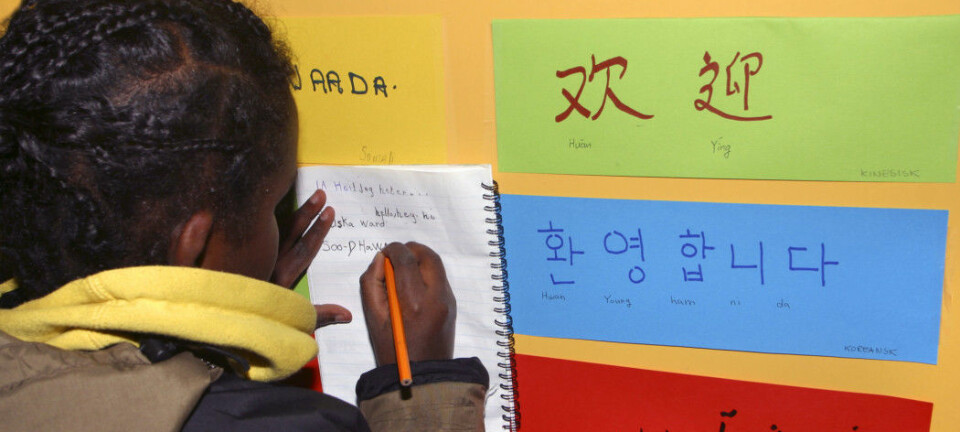
What happens to Norwegian children of immigrants as adults?
Their performance is a bit weaker than that of other children in elementary school, and somewhat fewer students complete upper secondary school. Compared to their parents, the difference is considerable. Many Norwegian-born persons with immigrant backgrounds are also doing far better financially than their parents. Some earn more than other Norwegians.
Children born in Norway to two immigrant parents constitute 3.4 per cent of the Norwegian population today. In 1970, that figure was only 0.06 per cent.
Statistics Norway has released an updated report for which they gathered figures, facts and research on this new population group.
Have the children of immigrants integrated into Norwegian society? Or do they remain outsiders?
Almost 180 000 immigrant children
In 2019, almost 180 000 people in Norway are the children of two immigrant parents.

Most of them are still children and adolescents. Only 14 per cent are older than 25, but this group has now become so large that statistics and research can tell us a great deal about how the integration of immigrants into Norwegian society is going.
Children of two immigrants in Norway who are 25 or older often have parents with backgrounds from Pakistan, Vietnam, Turkey, India, Morocco or Chile.
The children of other large immigrant groups in Norway – Poles, Somalis, Lithuanians, Iraqis and Afghans – are still mostly younger.
School results
Children of immigrants do somewhat worse than children of Norwegian-born parents in primary school. Slightly fewer complete upper secondary education, according to education statistics.
However, the leap in education is still huge for many immigrant children, when compared with their parents' education. Children with parents from Sri Lanka and Vietnam achieve the top school results, despite the fact that many of these parents have had very little education themselves.
Many choose college prep
Fully 76 per cent of children with two immigrant parents who start upper secondary school choose college preparatory programmes. Among other teens, 64 per cent select that route.
Almost half of the immigrant children in the 25 to 40 year age group now have attained higher education, which is roughly equivalent to the rest of the population.
Among immigrant parents who only have a primary school education, 35 per cent of their children continue their education to university or college level. For the rest of the Norwegian population, the corresponding proportion is only 19 per cent.
Norwegian social scientists who have studied this topic refer to these immigrants and their children as having educational drive.
Children of immigrants from China, Sri Lanka, Vietnam and India are especially likely to pursue university or other higher education. Many immigrant children choose majors in economics and administration. Social sciences, law, trades and technical subjects are also common. Teaching careers are about as common for this group as for the rest of the population.
Vietnamese earn well
Statistics Norway's figures show notable differences in how many children of immigrants from different countries are found in the Norwegian labour market. Statistics Norway considers a person part of the labour force if her or his annual income approaches NOK 200 000 or more.
More Norwegian-born men and women between the ages of 25 and 40 with immigrant parents from Vietnam and India are employed than their Norwegian age peers without an immigrant background.
Today, 25 to 40 year old ethnic Vietnamese individuals born in Norway have a higher income on average than their age peers in the rest of the Norwegian population.
Many children of two immigrant parents have experience what social scientists call a class shift, or social mobility.
Chilean men earn the least
Adults in the same age group with parents from Turkey, Pakistan, Chile and Morocco have fewer people in the work force than their age peers in the non-immigrant population.
Women with Turkish backgrounds are the least linked to Norwegian working life.
In terms of income, Norwegian-born men with backgrounds from Vietnam, India and Pakistan often earn well, and many run their own businesses.
Norwegian-born men with Turkish or Moroccan backgrounds earn significantly less. The lowest wage earners are men with Chilean backgrounds.
Among Norwegian-born women, those with immigrant backgrounds from India and Vietnam earn the most, while women with backgrounds from Turkey and Chile earn the least.
Do both men and women work?
The available data is yielding steadily more information about marriage and cohabitation among the children of immigrants.
The rule among couples with Norwegian-born parents is that both partners tend to be employed. By contrast, Statistics Norway data shows considerable differences among adult children of immigrants in regards to whether both or just one partner works outside the home.
The lowest percentage of 25 to 40 year old couples with two working partners is found among Norwegian-born individuals with backgrounds from Turkey (53 per cent) and Pakistan (59 per cent). The highest percentage is among couples with backgrounds from India (86 per cent) and Vietnam (83 per cent).
--------------------------
Read the Norwegian version of this article at forskning.no
































